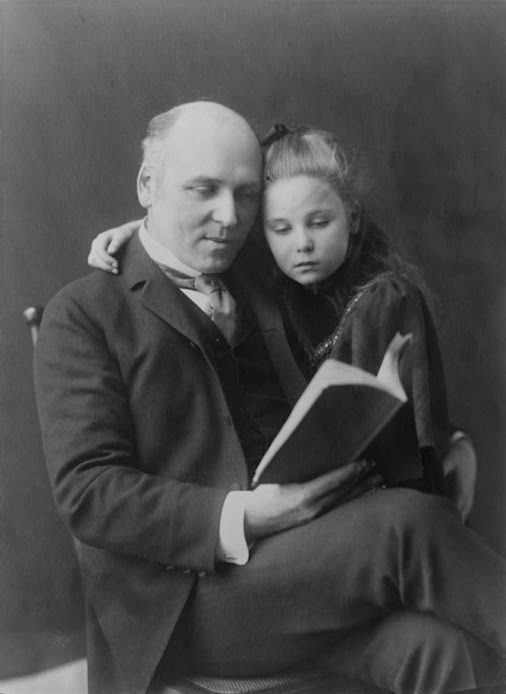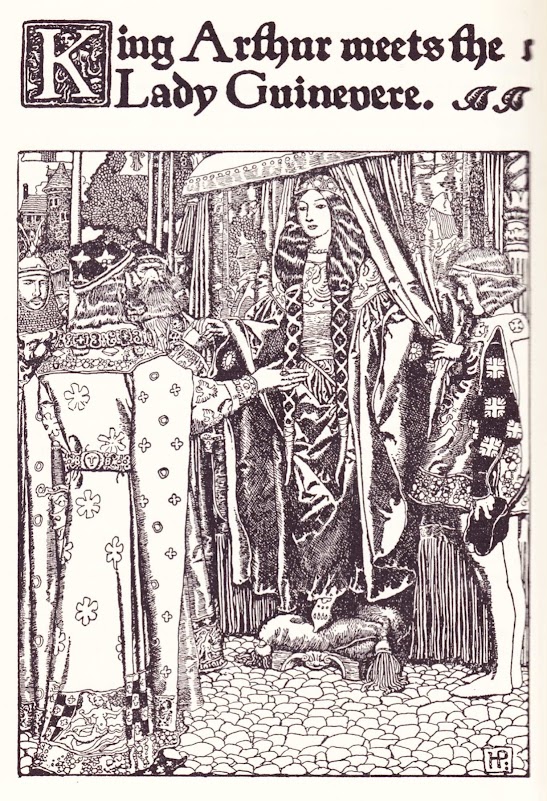 |
| 1896 Howard Pyle and daughter Phoebe photograph by Frances Benjamin Johnston |
Howard Pyle (1853, Wilmington Del. - 1911, Florence) was one of America’s most popular illustrators and storytellers at the end of the 19th century during a period of explosive growth in the publishing industry. His illustrations appeared in magazines like Harper’s Monthly, St. Nicholas, and Scribner’s Magazine, gaining him both national and international exposure. The broad appeal of his imagery made him a celebrity in his lifetime.
Pyle studied at the Art Student’s League, New York City, and first attracted attention by his line drawings after the style of Albrecht Dürer. His magazine and book illustrations are among the finest of the turn-of-the-century period in the Art Nouveau style. Pyle wrote original children’s stories as well as retelling old fairy tales. Many of Pyle’s children’s stories, illustrated by the author with vividness and historical accuracy, have become classics—most notably The Merry Adventures of Robin Hood (1883); Otto of the Silver Hand (1888); Jack Ballister’s Fortunes (1895); and his own folktales, Pepper & Salt (1886), The Wonder Clock (1888), and The Garden Behind the Moon (1895).
In 1894, he began teaching illustration at the Drexel Institute of Art, Science, and Industry. Among his students there wer valet Oakley, Maxfield Parrish, and Jessie Wikcox Smith. After 1900, he founded his own school of art and illustration named the Howard Pyle School of Illustration Art. Scholar Henry C. Pitz later used the term Brandywine School for the illustration artists and Wyeth family artists of the Brandywine region, several of whom had studied with Pyle. He had a lasting influence on a number of artists who became notable in their own right; N.C. Wyeth, Frank Schoonover, Thornton Oakley, Allen Tupper True, Stanley Arthur, and numerous others studied under him.
Later Pyle undertook mural paintings, executing, among others, The Battle of Nashville (1906) for the capitol at St. Paul, Minn. Dissatisfied with his style in painting, he went to Italy for further study but died shortly afterward. Pyle had established a free schoolof art in his home in Wilmington, where many successful American illustrators received their education.
Pyle travelled to Florence, Italy in 1910 to study mural painting. He died there in 1911 of a sudden kidney infection (Bright’s Disease).
For earlier works by Howard Pyle see parts 1-9 also.
This is part 10 of a 13-part series on the works of Howard Pyle:
1903 The Story of King Arthur and His Knights
published by Charles Scribner's Sons, New York:
 |
| Hard Cover |
 |
| The Story of King Arthur and His Knights "King Arthur of Britain." |
 |
| The Story of King Arthur and His Knights "Foreword." |
 |
| The Story of King Arthur and His Knights "Contents" |
 |
| The Story of King Arthur and His Knights |
 |
| The Story of King Arthur and His Knights "Arthur-Pendragon." |
 |
| The Story of King Arthur and His Knights "Prologue" |
 |
| The Story of King Arthur and His Knights "Sir Kay breaketh his sword, at ye Tournament." |
 |
| The Story of King Arthur and His Knights |
 |
| The Story of King Arthur and His Knights "Sir Kay showeth the mystic Sword unto Sir Ector." |
 |
| The Story of King Arthur and His Knights "How Arthur drew forth ye Sword." |
 |
| The Story of King Arthur and His Knights "In the Valley of Delight." |
 |
| The Story of King Arthur and His Knights |
 |
| The Story of King Arthur and His Knights "The Battle with the Sable Knight." |
 |
| The Story of King Arthur and His Knights "Excaliber the Sword." |
 |
| The Story of King Arthur and His Knights "The Lady Guinevere." |
 |
| The Story of King Arthur and His Knights |
 |
| The Story of King Arthur and His Knights "Two Knights do battles before Cameliard." |
 |
| The Story of King Arthur and His Knights "The White Champion meets two Knights at the Mill." |
 |
| The Story of King Arthur and His Knights "Four Knights serve the Gardener Lad." |
 |
| The Story of King Arthur and His Knights "The Gardener Lad takes off his Cap." |
 |
| The Story of King Arthur and His Knights "King Arthur meets the Lady Quinevere." |
 |
| The Story of King Arthur and His Knights "The Lady of ye Lake." |
 |
| The Story of King Arthur and His Knights "The Enchanter Merlin." |
 |
| The Story of King Arthur and His Knights "The Enchantress Vivien." |
 |
| The Story of King Arthur and His Knights "Vivien bewitches Merlin." |
 |
| The Story of King Arthur and His Knights "Queen Morgana le Fay." |
 |
| The Story of King Arthur and His Knights "Queen Morgana loses Excaliber his sheath." |
 |
| The Story of King Arthur and His Knights "Sir Pellias, the Gentle Knight." |
 |
| The Story of King Arthur and His Knights |
 |
| The Story of King Arthur and His Knights "Sir Pellias encounters the Sorrowful Lady in Arroy." |
 |
| The Story of King Arthur and His Knights "Parcenet covers Sir Pellias with a cloak." |
 |
| The Story of King Arthur and His Knights "The Lady of the Lake sits by the Fountain in Arroy." |
 |
| The Story of King Arthur and His Knights "Sir Gawaine sups with ye Lady Ettard." |
 |
| The Story of King Arthur and His Knights "The Lady of the Lake finds Sir Pellias wounded." |
 |
| The Story of King Arthur and His Knights "Sir Gawaine the Son of Lot, King of Orkney." |
 |
| The Story of King Arthur and His Knights |
 |
| The Story of King Arthur and His Knights "King Arthur findeth ye old woman in ye hut." |
 |
| The Story of King Arthur and His Knights "Sir Gawaine finds the beautiful Lady." |
 |
| 1904 Saint Joan of Arc Harper's Monthly, December 1904 |
 |
| 1904 The Haunted House Harper's Monthly, December 1904 |
 |
| 1904 The Island of Enchantment by Justus Miles Forman “He lay awhile conscious of great comfort" |
 |
| 1904 The Story of Adhelmar “He climbed the stairs slowly, for he was growing feeble” Harper's Monthly, April 1904 |
 |
| 1904 The Story of Adhelmar “He found Mélite alone” by James Branch Cabell Harper's Monthly, April 1904 |
 |
| 1904 The Story of Adhelmar “He sang for her as they sat in the gardens” Harper's Monthly, April 1904 |
 |
| 1905 An Attack on a Galleon oil on canvas 85.7 x 60.3 cm Delaware Art Museum |
 |
| 1905 “A man lay prone there, half turned upon his face” also known as “After the Battle” from "Melicent" Harper's Monthly, January 1905 |
 |
| 1905 “Sir John shook his spear at the ladies who sneered” from "Melicent" Harper's Monthly, January 1905 |
 |
| 1905 “With a cry, Shallum flung up his arms and jumped” from "An Amazing Belief" Harper's Monthly, April 1905 |
 |
| 1905 The Buccaneer was a Picturesque Fellow oil on canvas 30.5 x 19.5 cm Delaware Art Museum (Harrper's Monthly, December 1905 |
 |
| 1905 The Crown-Prince Karl, dead by his own hand Harper's Monthly, May 1905 |
 |
| 1905 The Yale Club bookplate (engraved by Edwin Davis French) |
 |
| 1906 Centurisa's Greeting for Century Association, New York |
 |
| 1906 Centurisa's Greeting for Century Association, New York |
 |
| 1906 Mary Dyer being led to the Scaffold McClures magazine, November 1906 |
 |
| 1906 McClure's Magazine |
No comments:
Post a Comment
Note: only a member of this blog may post a comment.